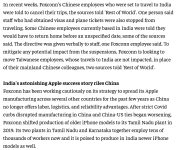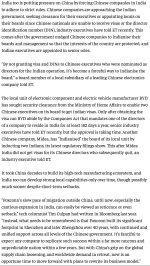Make in India: Optiemus begins telecom equipment manufacturing with Tejas Networks
Stock Markets
Published 20-08-2024, 06:46 pm

Sanjay Nayak, 53, CEO & MD, Tejas Networks.
New Delhi, Aug 20 (IANS) Homegrown Optiemus Electronics on Tuesday announced its foray into telecom equipment manufacturing with Tata Group’s Tejas Networks (NS:TEJS) as a manufacturing partner, at a time when the government has doubled down on indigenous designing and manufacturing of telecom equipment.Optiemus is working with Tejas Networks as a manufacturing partner for a wide array of telecom equipment products like 4G base band units /remote radio head/ONT/ONU/broadband switches and routers from its Noida manufacturing facility.
“It is a momentous occasion as we expand our manufacturing capabilities to foray into the growing industry of telecom equipment manufacturing,” said A Gururaj, MD, Optiemus Electronics.
According to the government, India-manufactured telecom equipment are now being exported to over 100 countries. Last year, the country exported telecom equipment and services worth more than $18.2 billion.
Several homegrown telecom companies have made their mark in Western nations, including the US, despite fierce global competition.
In the meantime, Tejas Networks has evolved as a strong trusted partner in the Indian telecom ecosystem over the last decade.
“In our continuous pursuance towards Atmanirbhar Bharat, adding Optiemus, as one of our manufacturing partners, will provide a boost to the domestic manufacturing of telecom products,” said V Sembian, Chief Supply Chain Officer, Tejas Networks.
Optiemus has two manufacturing units in Noida. Tejas Networks designs and manufactures high-performance wireline and wireless networking products for telecommunications service providers, internet service providers, utilities, defence and government entities in over 75 countries.
The Centre informed recently that the telecom equipment manufacturing sales have crossed Rs 50,000 crore under the production-linked incentive (PLI) scheme, creating more than 17,800 direct jobs and many more indirect jobs.
The telecom equipment production exceeded the milestone of Rs 50,000 crore with exports at about Rs 10,500 crore, according to the Ministry of Communications.
https://in.investing.com/news/make-...ent-manufacturing-with-tejas-networks-4393273
Stock Markets
Published 20-08-2024, 06:46 pm

Sanjay Nayak, 53, CEO & MD, Tejas Networks.
New Delhi, Aug 20 (IANS) Homegrown Optiemus Electronics on Tuesday announced its foray into telecom equipment manufacturing with Tata Group’s Tejas Networks (NS:TEJS) as a manufacturing partner, at a time when the government has doubled down on indigenous designing and manufacturing of telecom equipment.Optiemus is working with Tejas Networks as a manufacturing partner for a wide array of telecom equipment products like 4G base band units /remote radio head/ONT/ONU/broadband switches and routers from its Noida manufacturing facility.
“It is a momentous occasion as we expand our manufacturing capabilities to foray into the growing industry of telecom equipment manufacturing,” said A Gururaj, MD, Optiemus Electronics.
According to the government, India-manufactured telecom equipment are now being exported to over 100 countries. Last year, the country exported telecom equipment and services worth more than $18.2 billion.
Several homegrown telecom companies have made their mark in Western nations, including the US, despite fierce global competition.
In the meantime, Tejas Networks has evolved as a strong trusted partner in the Indian telecom ecosystem over the last decade.
“In our continuous pursuance towards Atmanirbhar Bharat, adding Optiemus, as one of our manufacturing partners, will provide a boost to the domestic manufacturing of telecom products,” said V Sembian, Chief Supply Chain Officer, Tejas Networks.
Optiemus has two manufacturing units in Noida. Tejas Networks designs and manufactures high-performance wireline and wireless networking products for telecommunications service providers, internet service providers, utilities, defence and government entities in over 75 countries.
The Centre informed recently that the telecom equipment manufacturing sales have crossed Rs 50,000 crore under the production-linked incentive (PLI) scheme, creating more than 17,800 direct jobs and many more indirect jobs.
The telecom equipment production exceeded the milestone of Rs 50,000 crore with exports at about Rs 10,500 crore, according to the Ministry of Communications.
https://in.investing.com/news/make-...ent-manufacturing-with-tejas-networks-4393273
























